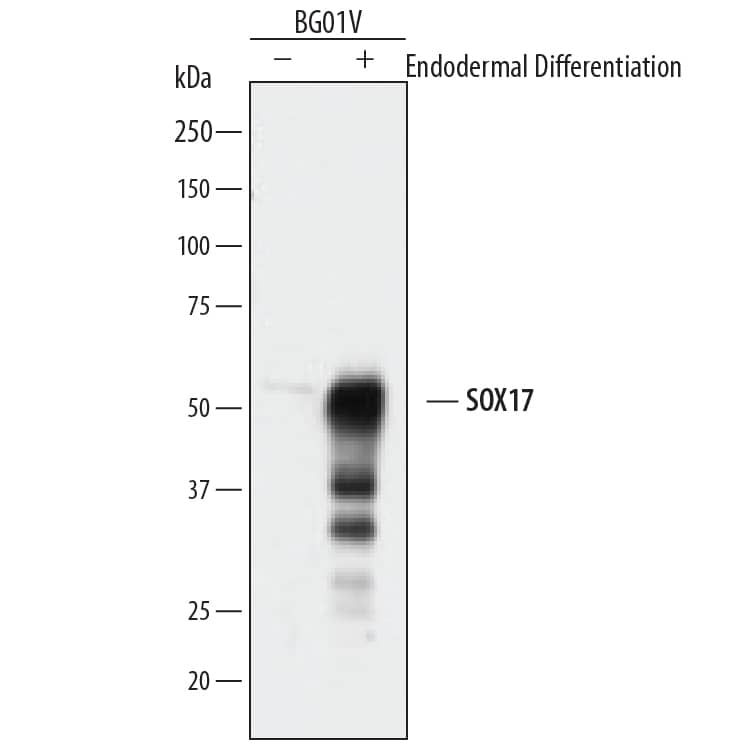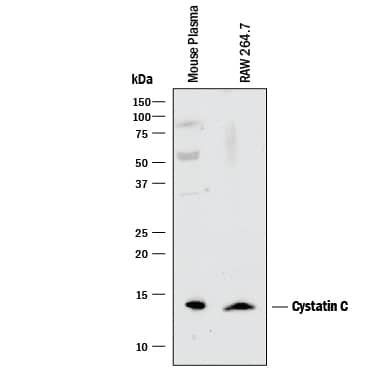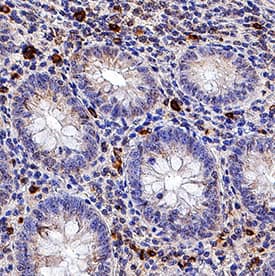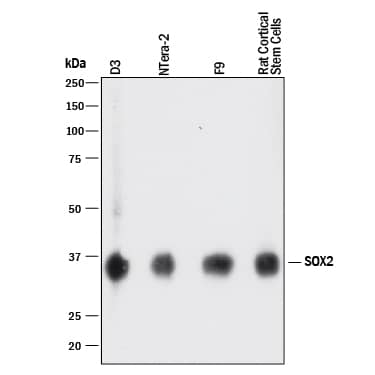Mouse Clusterin Antibody Summary
Glu22-Glu448
Accession # Q06890
Customers also Viewed
Applications
Mouse Clusterin Sandwich Immunoassay
Please Note: Optimal dilutions should be determined by each laboratory for each application. General Protocols are available in the Technical Information section on our website.
Scientific Data
 View Larger
View Larger
Clusterin in Mouse Liver. Clusterin was detected in perfusion fixed frozen sections of mouse liver using Goat Anti-Mouse Clusterin Antigen Affinity-purified Polyclonal Antibody (Catalog # AF2747) at 15 µg/mL overnight at 4 °C. Tissue was stained using the Anti-Goat HRP-DAB Cell & Tissue Staining Kit (brown; Catalog # CTS008) and counterstained with hematoxylin (blue). Lower panel shows a lack of labeling if primary antibodies are omitted and tissue is stained only with secondary antibody followed by incubation with detection reagents. View our protocol for Chromogenic IHC Staining of Frozen Tissue Sections.
 View Larger
View Larger
Clusterin in Mouse Intestine. Clusterin was detected in perfusion fixed frozen sections of mouse intestine using Goat Anti-Mouse Clusterin Antigen Affinity-purified Polyclonal Antibody (Catalog # AF2747) at 15 µg/mL overnight at 4 °C. Tissue was stained using the Anti-Goat HRP-DAB Cell & Tissue Staining Kit (brown; Catalog # CTS008) and counterstained with hematoxylin (blue). Lower panel shows a lack of labeling if primary antibodies are omitted and tissue is stained only with secondary antibody followed by incubation with detection reagents. View our protocol for Chromogenic IHC Staining of Frozen Tissue Sections.
 View Larger
View Larger
Detection of Human Clusterin/APOJ by Western Blot Conservation of clusterin‐dependent alpha ‐synuclein preformed fibrils (pffs) uptake from mouse to human astrocytes. (a) Representative image of hiAstrocytes (27 days of differentiation) treated with * alpha ‐synuclein pffs for 48 hr. Scale bar 10 μm. (b) Cell lysates from hiAstrocytes (27 days of differentiation) treated with alpha ‐synuclein pffs, or monomeric alpha ‐synuclein (m), for 48 hr were subjected to immunoblotting using alpha ‐synuclein and GAPDH antibodies. Asterisks in the alpha ‐synuclein immunoblot indicate alpha ‐synuclein nonspecific bands. (c) Medium from hiAstrocytes (27 days of differentiation) treated with alpha ‐synuclein pffs, or monomeric alpha ‐synuclein (M), for 48 hr were subjected to immunoblotting using clusterin antibody. Ponceau‐S staining was used as loading control. (d) Quantification of clusterin is normalized to GAPDH protein of cell lysates. Data are representative of three independent experiments and are expressed as the mean ± SD. Data were analyzed using unpaired t test; *p = .0446. (e) Cell lysates from hiAstrocytes (31 days of differentiation) transfected with negative control (NC) or clusterin siRNA for 24 hr were subjected to immunoblotting using clusterin and GAPDH antibodies. Asterisk in the clusterin immunoblot indicates clusterin nonspecific band. (f) Quantification of clusterin precursor is normalized to GAPDH. Data are representative of three independent experiments and are expressed as the mean ± SD. Data were analyzed using unpaired t test; *p =.0165. (g) Representative images of hiAstrocytes (35 days of differentiation) transfected with NC or clusterin siRNA and treated with * alpha ‐synuclein pffs for 24 hr. Scale bar 10 μm. (h) Quantification of * alpha ‐synuclein pffs is shown as mean of fluorescence intensity from three independent experiments (~50 cells per experiment). Quantification of * alpha ‐synuclein pffs is calculated as fluorescence intensity divided by the cell area (μm2). Data are expressed as the mean ± SD. Data were analyzed using unpaired t test; *p =.0178. Individual points of the graphs represent each single experiment [Color figure can be viewed at wileyonlinelibrary.com] Image collected and cropped by CiteAb from the following publication (https://pubmed.ncbi.nlm.nih.gov/33045109), licensed under a CC-BY license. Not internally tested by R&D Systems.
 View Larger
View Larger
Detection of Mouse Clusterin/APOJ by Western Blot Extracellular clusterin limits the uptake of alpha ‐synuclein preformed fibrils (pffs) by murine primary astrocytes. (a) Cell lysates from clusterin wild‐type (WT) and knock‐out (KO) astrocytes were subjected to immunoblotting using clusterin and GAPDH antibodies. Asterisk indicates clusterin precursor. (b) Maximum intensity Z‐projection confocal images of clusterin WT and KO astrocytes treated with * alpha ‐synuclein pffs for 4 hr. Scale bar 5 μm. (c) Quantification of * alpha ‐synuclein pffs is shown as mean of fluorescence intensity from six independent experiments (~50 cells per experiment). Quantification of * alpha ‐synuclein pffs is calculated as fluorescence intensity divided by the cell area (μm2). Data are expressed as the mean ± SD. Data were analyzed using unpaired t test; *p =.0315. (d) Cell lysates from clusterin WT and KO primary astrocytes treated with pffs for 16 hr were subjected to immunoblotting using alpha ‐synuclein and GAPDH antibodies. (e) Quantification of intracellular alpha ‐synuclein is normalized to GAPDH protein. Data are representative of eight independent experiments and are expressed as the mean ± SD. Data were analyzed using unpaired t test; *p = .0239. (f) Cell lysates from clusterin KO primary astrocytes treated with pffs for 16 hr in a medium containing or not containing extracellular clusterin were subjected to immunoblotting using alpha ‐synuclein, clusterin and GAPDH antibodies. (g) Quantification of intracellular alpha ‐synuclein is normalized to GAPDH protein. Data are representative of four independent experiments and are expressed as the mean ± SD. Data were analyzed using unpaired t test; *p =.0134. (h) Cell lysates from clusterin WT and KO primary astrocytes treated with pffs and chloroquine (CQ) for 16 hr were subjected to immunoblotting using alpha ‐synuclein and GAPDH antibodies. (i) Quantification of intracellular alpha ‐synuclein normalized to GAPDH protein. Data are representative of six independent experiments and are expressed as the mean ± SD. Data were analyzed using unpaired t test; *p =.0377. Individual points of the graphs represent each single experiment [Color figure can be viewed at wileyonlinelibrary.com] Image collected and cropped by CiteAb from the following publication (https://pubmed.ncbi.nlm.nih.gov/33045109), licensed under a CC-BY license. Not internally tested by R&D Systems.
 View Larger
View Larger
Detection of Mouse Clusterin/APOJ by Western Blot Clusterin protein levels are increased in two different animal models of Parkinson's disease. (a) Lysates from contralateral and ipsilateral ventral midbrain of mice injected with adeno‐associated virus (AAV)‐h alpha ‐synuclein and sacrificed after 8 weeks were subjected to immunoblotting using clusterin and GAPDH antibodies. (b) Quantification of total cleaved clusterin is normalized to GAPDH protein. Data are representative of five animals and are expressed as the mean ± SD. Data were analyzed using one‐sample t test; *p = .0253. (c) Representative images of clusterin‐GFAP double labeling in the ipsilateral and contralateral striatum of mice injected with AAV‐h alpha ‐synuclein and sacrificed after 8 weeks. Scale bar 20 μm. (d) Representative images of clusterin‐S100 beta double labeling in the substantia nigra of mice injected with alpha ‐synuclein preformed fibrils (pffs) and sacrificed after 4 weeks. Scale bar 20 μm. (e) Representative images of clusterin‐S100 beta double labeling in the striatum of mice injected with alpha ‐synuclein pffs and sacrificed after 4 weeks. Scale bar 20 μm [Color figure can be viewed at wileyonlinelibrary.com] Image collected and cropped by CiteAb from the following publication (https://pubmed.ncbi.nlm.nih.gov/33045109), licensed under a CC-BY license. Not internally tested by R&D Systems.
 View Larger
View Larger
Detection of Human Clusterin/APOJ by Western Blot Conservation of clusterin‐dependent alpha ‐synuclein preformed fibrils (pffs) uptake from mouse to human astrocytes. (a) Representative image of hiAstrocytes (27 days of differentiation) treated with * alpha ‐synuclein pffs for 48 hr. Scale bar 10 μm. (b) Cell lysates from hiAstrocytes (27 days of differentiation) treated with alpha ‐synuclein pffs, or monomeric alpha ‐synuclein (m), for 48 hr were subjected to immunoblotting using alpha ‐synuclein and GAPDH antibodies. Asterisks in the alpha ‐synuclein immunoblot indicate alpha ‐synuclein nonspecific bands. (c) Medium from hiAstrocytes (27 days of differentiation) treated with alpha ‐synuclein pffs, or monomeric alpha ‐synuclein (M), for 48 hr were subjected to immunoblotting using clusterin antibody. Ponceau‐S staining was used as loading control. (d) Quantification of clusterin is normalized to GAPDH protein of cell lysates. Data are representative of three independent experiments and are expressed as the mean ± SD. Data were analyzed using unpaired t test; *p = .0446. (e) Cell lysates from hiAstrocytes (31 days of differentiation) transfected with negative control (NC) or clusterin siRNA for 24 hr were subjected to immunoblotting using clusterin and GAPDH antibodies. Asterisk in the clusterin immunoblot indicates clusterin nonspecific band. (f) Quantification of clusterin precursor is normalized to GAPDH. Data are representative of three independent experiments and are expressed as the mean ± SD. Data were analyzed using unpaired t test; *p =.0165. (g) Representative images of hiAstrocytes (35 days of differentiation) transfected with NC or clusterin siRNA and treated with * alpha ‐synuclein pffs for 24 hr. Scale bar 10 μm. (h) Quantification of * alpha ‐synuclein pffs is shown as mean of fluorescence intensity from three independent experiments (~50 cells per experiment). Quantification of * alpha ‐synuclein pffs is calculated as fluorescence intensity divided by the cell area (μm2). Data are expressed as the mean ± SD. Data were analyzed using unpaired t test; *p =.0178. Individual points of the graphs represent each single experiment [Color figure can be viewed at wileyonlinelibrary.com] Image collected and cropped by CiteAb from the following publication (https://pubmed.ncbi.nlm.nih.gov/33045109), licensed under a CC-BY license. Not internally tested by R&D Systems.
 View Larger
View Larger
Detection of Mouse Clusterin/APOJ by Western Blot Extracellular clusterin limits the uptake of alpha ‐synuclein preformed fibrils (pffs) by murine primary astrocytes. (a) Cell lysates from clusterin wild‐type (WT) and knock‐out (KO) astrocytes were subjected to immunoblotting using clusterin and GAPDH antibodies. Asterisk indicates clusterin precursor. (b) Maximum intensity Z‐projection confocal images of clusterin WT and KO astrocytes treated with * alpha ‐synuclein pffs for 4 hr. Scale bar 5 μm. (c) Quantification of * alpha ‐synuclein pffs is shown as mean of fluorescence intensity from six independent experiments (~50 cells per experiment). Quantification of * alpha ‐synuclein pffs is calculated as fluorescence intensity divided by the cell area (μm2). Data are expressed as the mean ± SD. Data were analyzed using unpaired t test; *p =.0315. (d) Cell lysates from clusterin WT and KO primary astrocytes treated with pffs for 16 hr were subjected to immunoblotting using alpha ‐synuclein and GAPDH antibodies. (e) Quantification of intracellular alpha ‐synuclein is normalized to GAPDH protein. Data are representative of eight independent experiments and are expressed as the mean ± SD. Data were analyzed using unpaired t test; *p = .0239. (f) Cell lysates from clusterin KO primary astrocytes treated with pffs for 16 hr in a medium containing or not containing extracellular clusterin were subjected to immunoblotting using alpha ‐synuclein, clusterin and GAPDH antibodies. (g) Quantification of intracellular alpha ‐synuclein is normalized to GAPDH protein. Data are representative of four independent experiments and are expressed as the mean ± SD. Data were analyzed using unpaired t test; *p =.0134. (h) Cell lysates from clusterin WT and KO primary astrocytes treated with pffs and chloroquine (CQ) for 16 hr were subjected to immunoblotting using alpha ‐synuclein and GAPDH antibodies. (i) Quantification of intracellular alpha ‐synuclein normalized to GAPDH protein. Data are representative of six independent experiments and are expressed as the mean ± SD. Data were analyzed using unpaired t test; *p =.0377. Individual points of the graphs represent each single experiment [Color figure can be viewed at wileyonlinelibrary.com] Image collected and cropped by CiteAb from the following publication (https://pubmed.ncbi.nlm.nih.gov/33045109), licensed under a CC-BY license. Not internally tested by R&D Systems.
Preparation and Storage
- 12 months from date of receipt, -20 to -70 °C as supplied.
- 1 month, 2 to 8 °C under sterile conditions after reconstitution.
- 6 months, -20 to -70 °C under sterile conditions after reconstitution.
Background: Clusterin
Clusterin, also known as Apolipoprotein J, Sulfated Glycoprotein 2 (SGP-2), TRPM-2, and SP-40,40, is a secreted multifunctional protein that was named for its ability to induce cellular clustering. It binds a wide range of molecules and may function as a chaperone of misfolded extracellular proteins. It also participates in the control of cell proliferation, apoptosis, and carcinogenesis (1, 2). Clusterin is predominantly expressed in adult testis, ovary, adrenal gland, liver, heart, and brain and in many epithelial tissues during embryonic development (3). Mouse Clusterin is synthesized as a precursor that contains two coiled coil domains, two nuclear localization signals (NLS), and one heparin binding domain (3-6). Intracellular cleavages of the precursor remove the signal peptide and generate comparably sized alpha and beta chains which are secreted as an 80 kDa N-glycosylated disulfide-linked heterodimer (7, 8). Mature mouse Clusterin shares 77% and 93% amino acid sequence identity with human and rat Clusterin, respectively. High μg/mL concentrations of Clusterin circulate predominantly as a component of high density lipoprotein particles, and these are internalized and degraded through interactions with LRP-2/Megalin (9, 10). In human, an alternately spliced 50 kDa isoform of Clusterin (nCLU) lacks the signal peptide and remains intracellular (5, 11). This molecule is neither glycosylated nor cleaved into alpha and beta chains (11). In the cytoplasm, nCLU destabilizes the actin cytoskeleton and inhibits NF kappa B activation (12, 13). Cellular exposure to ionizing radiation promotes the translocation of nCLU to the nucleus where it interacts with Ku70 and promotes apoptosis (5, 11). This function contrasts with the cytoprotective effect of secreted Clusterin (14). During colon cancer tumor progression there is a downregulation of the intracellular form and an upregulation of the glycosylated secreted form (11).
- Carver, J.A. et al. (2003) IUBMB Life 55:661.
- Shannan, B. et al. (2006) Cell Death Differ. 13:12.
- French, L.E. et al. (1993) J. Cell Biol. 122:1119.
- Lee, K.H. et al. (1993) Biochem. Biophys. Res. Commun. 194:1175.
- Leskov, K.S. et al. (2003) J. Biol. Chem. 278:11590.
- Pankhurst, G.J. et al. (1998) Biochemistry 37:4823.
- Burkey, B.F. et al. (1991) J. Lipid. Res. 32:1039.
- de Silva, H.V. et al. (1990) J. Biol. Chem. 265:14292.
- Jenne, D.E. et al. (1991) J. Biol. Chem. 266:11030.
- Kounnas, M.Z. et al. (1995) J. Biol. Chem. 270:13070.
- Pucci, S. et al. (2004) Oncogene 23:2298.
- Moretti, R. M. et al. (2007) Cancer Res. 67:10325.
- Santilli, G. et al. (2003) J. Biol. Chem. 278:38214.
- Trougakos, I.P. et al. (2004) Cancer Res. 64:1834.
Product Datasheets
Citations for Mouse Clusterin Antibody
R&D Systems personnel manually curate a database that contains references using R&D Systems products. The data collected includes not only links to publications in PubMed, but also provides information about sample types, species, and experimental conditions.
13
Citations: Showing 1 - 10
Filter your results:
Filter by:
-
Proteomic alterations in the brain and blood-brain barrier during brain A beta accumulation in an APP knock-in mouse model of Alzheimer's disease
Authors: Shingo Ito, Ryotaro Yagi, Seiryo Ogata, Takeshi Masuda, Takashi Saito, Takaomi Saido et al.
Fluids Barriers CNS
-
Physical exercise modulates the microglial complement pathway in mice to relieve cortical circuitry deficits induced by mutant human TDP-43
Authors: JA Wei, L Liu, X Song, B Lin, J Cui, L Luo, Y Liu, S Li, X Li, KF So, S Yan, L Zhang
Cell Reports, 2023-03-15;42(3):112240.
Species: Mouse
Sample Types: In Vivo, Whole Tissue
Applications: IHC, Neutralization -
LRRK2 Kinase Inhibition Attenuates Astrocytic Activation in Response to Amyloid beta1-42 Fibrils
Authors: A Filippini, V Salvi, V Dattilo, C Magri, S Castrezzat, R Veerhuis, D Bosisio, M Gennarelli, I Russo
Biomolecules, 2023-02-06;13(2):.
Species: Mouse
Sample Types: Cell Lysates
Applications: Western Blot -
Lesion environments direct transplanted neural progenitors towards a wound repair astroglial phenotype in mice
Authors: O'Shea TM, Ao Y, Wang S et al.
Nature Communications
-
Intestinal fibroblastic reticular cell niches control innate lymphoid cell homeostasis and function
Authors: HW Cheng, U Mörbe, M Lütge, C Engetschwi, L Onder, M Novkovic, C Gil-Cruz, C Perez-Shib, T Hehlgans, E Scandella, B Ludewig
Nature Communications, 2022-04-19;13(1):2027.
Species: Mouse
Sample Types: Whole Tissue
Applications: IHC -
Regulation of Helicobacter-induced gastritis by programmed death ligand 1-expressing classical dendritic cells
Authors: DM Go, SH Lee, SH Lee, SH Woo, K Kim, K Kim, KS Park, JH Park, SJ Ha, WH Kim, JH Choi, DY Kim
Cellular and Molecular Gastroenterology and Hepatology, 2021-04-21;0(0):.
Species: Mouse
Sample Types: Whole Cells, Whole Tissue
Applications: ICC, IHC -
Ascl2-Dependent Cell Dedifferentiation Drives Regeneration of Ablated Intestinal Stem Cells
Authors: K Murata, U Jadhav, S Madha, J van Es, J Dean, A Cavazza, K Wucherpfen, F Michor, H Clevers, RA Shivdasani
Cell Stem Cell, 2020-02-20;0(0):.
Species: Mouse
Sample Types: Whole Cells
Applications: ICC/IF -
Clusterin is a potential lymphotoxin beta receptor target that is upregulated and accumulates in germinal centers of mouse spleen during immune response.
Authors: Afanasyeva M, Britanova L, Korneev K, Mitkin N, Kuchmiy A, Kuprash D
PLoS ONE, 2014-05-27;9(5):e98349.
Species: Mouse
Sample Types: Tissue Homogenates, Whole Tissue
Applications: IHC, Western Blot -
Association of Plasma Clusterin Concentration With Severity, Pathology, and Progression in Alzheimer Disease
Authors: Madhav Thambisetty, Andrew Simmons, Latha Velayudhan, Abdul Hye, James Campbell, Yi Zhang et al.
Archives of General Psychiatry
-
Urinary clusterin, cystatin C, beta2-microglobulin and total protein as markers to detect drug-induced kidney injury.
Authors: Dieterle F, Perentes E, Cordier A, Roth DR, Verdes P, Grenet O, Pantano S, Moulin P, Wahl D, Mahl A, End P, Staedtler F, Legay F, Carl K, Laurie D, Chibout SD, Vonderscher J, Maurer G
Nat. Biotechnol., 2010-05-01;28(5):463-9.
Species: Human
Sample Types: Urine
Applications: ELISA Development -
Integrated genomic and proteomic analyses identify stimulus-dependent molecular changes associated with distinct modes of skeletal muscle atrophy
Authors: Hunt LC, Graca FA, Pagala V Et al.
Cell reports
-
Single-cell RNA-Seq resolves cellular complexity in sensory organs from the neonatal inner ear.
Authors: Burns JC, Kelly MC, Hoa M et al.
Nat Commun
-
Extracellular clusterin limits the uptake of alpha-synuclein fibrils by murine and human astrocytes
Authors: Filippini A, Mutti V, Faustini G et al.
Glia
FAQs
No product specific FAQs exist for this product, however you may
View all Antibody FAQsIsotype Controls
Reconstitution Buffers
Secondary Antibodies
Reviews for Mouse Clusterin Antibody
Average Rating: 5 (Based on 2 Reviews)
Have you used Mouse Clusterin Antibody?
Submit a review and receive an Amazon gift card.
$25/€18/£15/$25CAN/¥75 Yuan/¥2500 Yen for a review with an image
$10/€7/£6/$10 CAD/¥70 Yuan/¥1110 Yen for a review without an image
Filter by:
- Reconstituted SP size in 125 uL of PBS
- 10% gel; 20ug of total protein
- Diluted primary antibody 1:500 in 5% milk overnight
- Diluted secondary antibody (goat) 1:5000 in 5% milk (non-R&D) for 45 minutes
- Two bands seen at



















